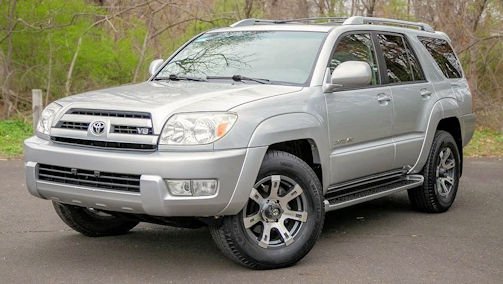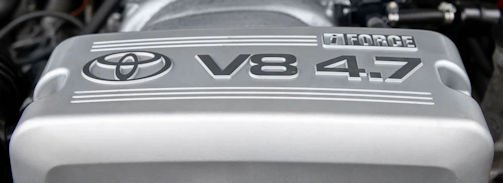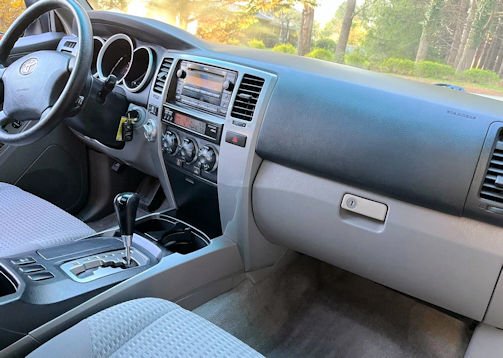Toyota 4Runner 4th generation (N210)
 |
|
|
Production period: |
2002 to 2009 |
|
Body versions: |
station wagon |
|
Engines: |
Gasoline : 4.0-4.7 litres |
|
Length: |
4803-4806 mm |
|
Width: |
1875-1910 mm |
|
Height: |
1750-1811 mm |
|
Wheelbase: |
2789 mm |
The new 4Runner was introduced in October 2002 as a model 2003.
History
It was now officially offered only in North America and Asia. In other markets, the segment partly took over the Land Cruiser Prado or the Toyota RAV4. The fourth generation of the 4Runner had major changes to the chassis, but aimed at the same clientele as the third generation. The new 4Runner was based on the Land Cruiser Prado 120 Series, retained its styling and was marketed in the segment of the more luxurious SUV with off-road qualities. Available were the equipment lines SR5, Sport Edition and Limited, the production engine is the all-new, low-emission 4.0-liter V6, type Toyota 1GR-FE, but for the first time there is also a V8 engine with 4.7-liter displacement, type 2UZ-FE, the 260 bhp (194 kW) and offers a torque of 415 Nm. Rear-wheel-drive V6 models can tow 2265 kg, rear-wheel-drive V8 models 3307 kg. In the all-wheel models, this value is 3171 kg. When introduced, the SR5 and Sport Edition models had gray plastic applications and bumpers. The sports models also had a non-functional scoop on the hood. As standard, a 5-speed automatic transmission was installed.
The front wheels were suspended on double wishbones, while the rear axle hung on four links on each side. The 4Runner also had a separate frame and a rigid axle at the rear, a construction that combines strength and durability in off-road driving with good road handling and large interior space. The optionally available four-wheel drive system was permanently on the V8 and on the V6 switchable; both had a Torsen differential in the middle, but only the V8 model could be locked. A new suspension, the X-Relative Absorber System(X-REAS), came as standard on the Sport Edition and on request also on the SR5 or Limited. The latter included air suspension with automatic level control. The X-REAS connects the shock absorbers through hoses diagonally to each other to reduce the side tilt on sharp corners. All 4Runners were equipped with engine glide plates, four-wheel drive and petrol tank to prevent off-road damage. The Hill Start Assist (HAC) prevented rollback when starting on the mountain, and the downhill assistance (DAC, only in four-wheel drive) automatically controlled gas and brake intervention at very slow downhill. Both systems were delivered as standard on the four-wheel drive versions.

The standard equipment also included a steering column adjustable in inclination and length, electronic keyless entry, dual-zone automatic air conditioning, electrically operated lumbar support for the driver, an electrically operated rear window and, in the case of the V8 models, a hitch for direct connection was attached to the rear cross member. On request were available: garage door opener (" HomeLink "), an electro chromatic dimmable rear-view mirror, electrically operated sunroof, third seat, DVD based navigation system, JBL stereo system with ten loudspeakers and audio system for rear seat passengers. As an option, there was also a system of two reversing cameras (each mounted on the right and left D-pillar).
Security Aspects
All 4Runners had Toyota's Star Safety System, which included ABS, Electronic Brake Force Distribution (EBD), Brake Assist (BAS), Traction Control (TCS) and Stability Control (VSC). In the model years 2005 to 2007, the side airbags were available on request at the front, from 2008 they were standard equipment.
In April 2007, the report from the Insurance Institute for Highway Safety (IIHS) showed that the 4Runner had one of the lowest rates of fatal accidents between 2002 and 2005 (13 per 1 million registered vehicles). Only the Infiniti G35 and BMW 7 Series had even lower rates. The IIHS rates the 4Runner N210 as generally "good" for frontal offset impact and also generally "good" for side impact (vehicles with side airbags). These are the best results for a pickup-derived mid-size SUV. The 4Runner got a "good" in 13 out of 14 tested categories.
Crash test assessments of the National Highway Traffic Safety Administration (NHTSA) (2003)
|
Front impact driver: |
4 stars |
|
Front impact passenger: |
4 stars |
|
Side impact driver: |
5 Stars |
|
Side impact rear seat passenger: |
5 Stars |
|
Rollover: |
3 stars |
Special equipment TRD
Changes from model year to model year

- In early 2003, Toyota offered an optional equipment package for the SR5, which included applications and bumpers in body colour. In April 2003, this additional equipment package, along with fog lamps, running boards and 16-inch alloy wheels, became standard on the SR5. The Sport Edition also got black running boards and body colour applications instead of the gray applications and chrome grille, chrome door handles and chrome trim on the tailgate.
- In 2004, a tire pressure control system was added to the standard equipment. Upon request, a third bench was available for the SR5 and the Limited.
- The 2005 model year brought improvements to the optional V8 engine and made the five-speed automatic as standard on the V6 model. Outside, there were slight changes, such as bumper trim in body colour (instead of the silver-coloured (except Dorado Gold)) on the SR5 and Limited, a chrome grille on the SR5, black roof rails and black running boards (rather than the silver ones) on the Limited and a new rear spoiler. The exterior colour Salsa Red Pearl was introduced for all trim levels. A similar colour was already available for the third generation 4Runner.
- In 2006, the fourth generation was slightly revised. The changes included modified front and rear bumpers, a new grille, new projection headlamps, LED taillights, additional chrome trim for the SR5 and a smoky-chrome grille, a roof rail of tubes and step tread boards in the Sport Edition. The revised front bumper had round fog lights and newly arranged indicators and headlights. The revised rear bumper had no reflectors more. The audio system got connections for MP3 players and other devices. The equipment variant Limited differed by special 18-inch wheels and a memory system for the seats further from the other variants.
- In 2007, the 4Runner presented itself unchanged, only the new gray colour variant Shadow Mica came to it.
- In 2008, all 4Runners got standard side airbags with rollover sensors, a switch to disable the VSC, a slightly different grille, an improved tire pressure monitoring system, and some changes to the seat belt warning system and brake monitoring.
- In 2009 there was an Urban Runner Package for the Sport Edition. A Trail Edition package offered an electronically lockable differential, Advanced Traction Control (A-TRAC) and Bilstein shock absorbers.
